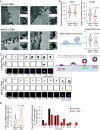HIV-1 budding requires cortical actin disassembly by the oxidoreductase MICAL1
- PMID: 39556735
- PMCID: PMC11621841
- DOI: 10.1073/pnas.2407835121
HIV-1 budding requires cortical actin disassembly by the oxidoreductase MICAL1
Abstract
Many enveloped viruses bud from the plasma membrane that is tightly associated with a dense and thick actin cortex. This actin network represents a significant challenge for membrane deformation and scission, and how it is remodeled during the late steps of the viral cycle is largely unknown. Using superresolution microscopy, we show that HIV-1 buds in areas of the plasma membrane with low cortical F-actin levels. We find that the cellular oxidoreductase MICAL1 locally depolymerizes actin at budding sites to promote HIV-1 budding and release. Upon MICAL1 depletion, F-actin abnormally remains at viral budding sites, incompletely budded viruses accumulate at the plasma membrane and viral release is impaired. Remarkably, normal viral release can be restored in MICAL1-depleted cells by inhibiting Arp2/3-dependent branched actin networks. Mechanistically, we find that MICAL1 directly disassembles branched-actin networks and controls the timely recruitment of the Endosomal Sorting Complexes Required for Transport scission machinery during viral budding. In addition, the MICAL1 activator Rab35 is recruited at budding sites, functions in the same pathway as MICAL1, and is also required for viral release. This work reveals a role for oxidoreduction in triggering local actin depolymerization to control HIV-1 budding, a mechanism that may be widely used by other viruses. The debranching activity of MICAL1 could be involved beyond viral budding in various other cellular functions requiring local plasma membrane deformation.
Keywords: Arp2/3; ESCRT; HIV-1 budding; MICAL1; actin.
Conflict of interest statement
Competing interests statement:The authors declare no competing interest.
Figures






References
-
- Garrus J. E., et al. , Tsg101 and the vacuolar protein sorting pathway are essential for HIV-1 budding. Cell 107, 55–65 (2001). - PubMed
-
- Martin-Serrano J., Zang T., Bieniasz P. D., HIV-1 and Ebola virus encode small peptide motifs that recruit Tsg101 to sites of particle assembly to facilitate egress. Nat. Med. 7, 1313–1319 (2001). - PubMed
-
- von Schwedler U. K., et al. , The protein network of HIV budding. Cell 114, 701–713 (2003). - PubMed
MeSH terms
Substances
Grants and funding
LinkOut - more resources
Full Text Sources

